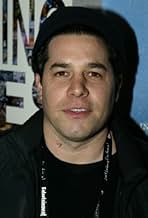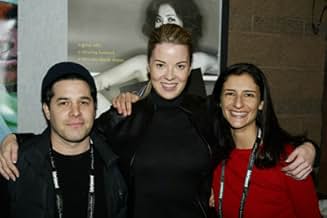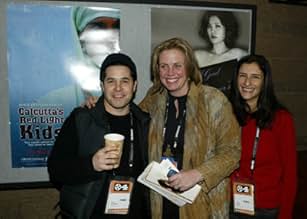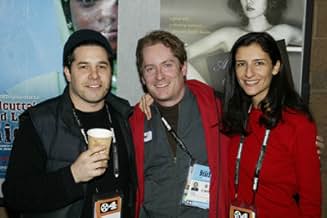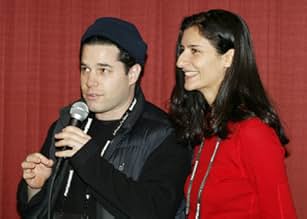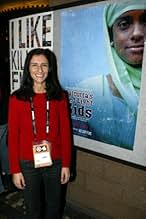Two documentary filmmakers chronicle their time in Sonagchi, Calcutta and the relationships they developed with children of prostitutes who work the city's notorious red light district.Two documentary filmmakers chronicle their time in Sonagchi, Calcutta and the relationships they developed with children of prostitutes who work the city's notorious red light district.Two documentary filmmakers chronicle their time in Sonagchi, Calcutta and the relationships they developed with children of prostitutes who work the city's notorious red light district.
- Won 1 Oscar
- 21 wins & 5 nominations total
- Directors
- Writers
- All cast & crew
- Production, box office & more at IMDbPro
Featured reviews
This film should be seen by everyone who has any sense of what the world is and can be if we give our attention and empathy to make it a better place --in the background I hear the greed and anger of Donald Trump and it is so jarring (and sad) and disturbing ....it is absolutely amazing the dedication and caring of Zana Briski an Ross Kauffman and their attempt to support and change the destinies of these poor unfortunate children who are doomed to a life of humiliation, poverty and human degradation. It is uplifting to know that there are people who care --who are not driven by greed and avarice-- who will try , no matter what the odds are, no matter what are the bureaucratic difficulties to help and support these poor unfortunate children .. I know that I have been immensely moved by this film and what is going on in a place like the red light district of Calcutta and will do what I can to make some impact with these unfortunate children in all of the various venues that these people have chosen to work in and do these miraculous things that are they are doing.
This is a beautifully conceived and directed film. I knew little about the red light district of Calcutta and certainly nothing of the amazing children whose photographs are not only dramatic but also a tool of empowerment, albeit not entirely successful. One of the best documentaries of 2004. There certainly have been several excellent movies about the misery and hopeless nature of life in red light districts throughout the world, particularly southeast Asia. But this film's decision to focus on the children who not only are born in the brothels, but essentially live their entire lives within this damp and dismal walls. Director/photographer Zana Briski is to commended for bringing this to light. Several of my friends had deep empathy for her frustrating experiences with the Indian bureaucracy as she tries to get the children's art work noticed. Great film.
10Dilip
Today I saw "Born into Brothels" at day 3 of 4 of the Full Frame Documentary Film Festival. Even with another day left, I have some confidence that this will be the film I most appreciated seeing at this festival, and in fact is one of the most inspiring films I have seen in a long time. Directors and producers Zana Briski and Ross Kauffman also hosted a question and answer session after the film, and I had the privilege of meeting and talking with Zana Briski, whose intimate involvement in this film and her selfless efforts have given me tremendous admiration for what she does; as I said in the Q&A period, if we had a few more people like her, the world would be a vastly better place for all of us.
Ms. Briski is an established photographer and now first time director who began in 1997 to explore the lives of sex workers in Calcutta's red-light district, Sonagachi, where over 7000 women and (disgustingly sadly) girls are prostitutes. In order to better understand them, Zana lived for months at a time with them, and the children quickly befriended her. The children were curious to try their hands at taking pictures, and Zana helped to empower them and see the world through their eyes by teaching them photography and acquiring point-and-shoot 35mm film cameras for them, as well as helping them to critique and edit their pictures.
The resulting pictures that the children took between the years 2000 and 2003 are striking. Some of the children clearly have innate talent in composition and artistry (see, for example, shot 17 "Girl on a Roof" or 14 "Horse", at the Kids with Cameras site mentioned at the bottom of my review), and all of them have works portraying the vitality of life so much so that Zana helped get one child invited to be part of a children's jury at a World Press Photo Foundation photo exhibit in Amsterdam in 2002, and for him to actually attend.
Zana admits in the film that she is not a social worker, but wanted very much to help the boys and girls, for otherwise their future was a dismal one lacking hope beyond prostitution, drugs, pimping, and crime. She organized a photo exhibit in a Calcutta bookstore, garnering Zana's project and the individual children television and newspaper coverage. Zana has recently set up an organization, Kids with Cameras, that sells their prints to raise money for them, with 100% of the profits going to them. Twelve of these prints were the ones chosen for the 2003 "Amnesty International" calendar, and she even exhibited and auctioned the children's work at Sotheby's. She has helped to get several of the children into good boarding schools and recently helped a few to get email access and English lessons.
The film itself is technically beautiful, with a melange of colors, sounds, and activity, centered on the children but also including others. The filmmakers in no way hide the unsavory life in Sonagachi, including disturbing cursing against the children, hopelessness of being able to in any way be involved in normal society, having no governmental support, facing tremendous bureaucracy to get anything changed even with Ms. Briski's help, and the total lack of police investigation or protection as painfully brought to light when one child's mother is killed by a pimp in a "kitchen fire". In making the film, Mr. Kauffman and Ms. Briski effectively used fast camera pans, red overtints, and grainy film at times to portray an environment where participants would not want to be carefully filmed. They could have made this a sad and detailed documentary about this red light slum, but instead chose to recognize its nature but focus on the innocence of the children and hope that could be offered them.
If you have the opportunity to see this film at a festival, don't miss it. I understand that HBO/Cinemax may be distributing the film as well to afford a much wider audience. It is a heartwarming film that left me with a jumble of emotions - hopefulness and hopelessness; incredulity and shock at human nature combined with tremendous admiration at the selflessness and difference that one person can make; sadness at the overwhelming poverty, filth, and insouciance of a society that lets a community like Songagachi exist and yet tremendous happiness at the children's glee in living their lives with innocent play and their ambition to move out of the community. For the quality and uniqueness of the film, as well as the tremendous service that Zana Briski portrays, this film gets 10 stars out of 10 in my book. Don't miss this jewel of a film - and consider supporting the work that goes on.
--Dilip Barman April 3, 2004
Ms. Briski is an established photographer and now first time director who began in 1997 to explore the lives of sex workers in Calcutta's red-light district, Sonagachi, where over 7000 women and (disgustingly sadly) girls are prostitutes. In order to better understand them, Zana lived for months at a time with them, and the children quickly befriended her. The children were curious to try their hands at taking pictures, and Zana helped to empower them and see the world through their eyes by teaching them photography and acquiring point-and-shoot 35mm film cameras for them, as well as helping them to critique and edit their pictures.
The resulting pictures that the children took between the years 2000 and 2003 are striking. Some of the children clearly have innate talent in composition and artistry (see, for example, shot 17 "Girl on a Roof" or 14 "Horse", at the Kids with Cameras site mentioned at the bottom of my review), and all of them have works portraying the vitality of life so much so that Zana helped get one child invited to be part of a children's jury at a World Press Photo Foundation photo exhibit in Amsterdam in 2002, and for him to actually attend.
Zana admits in the film that she is not a social worker, but wanted very much to help the boys and girls, for otherwise their future was a dismal one lacking hope beyond prostitution, drugs, pimping, and crime. She organized a photo exhibit in a Calcutta bookstore, garnering Zana's project and the individual children television and newspaper coverage. Zana has recently set up an organization, Kids with Cameras, that sells their prints to raise money for them, with 100% of the profits going to them. Twelve of these prints were the ones chosen for the 2003 "Amnesty International" calendar, and she even exhibited and auctioned the children's work at Sotheby's. She has helped to get several of the children into good boarding schools and recently helped a few to get email access and English lessons.
The film itself is technically beautiful, with a melange of colors, sounds, and activity, centered on the children but also including others. The filmmakers in no way hide the unsavory life in Sonagachi, including disturbing cursing against the children, hopelessness of being able to in any way be involved in normal society, having no governmental support, facing tremendous bureaucracy to get anything changed even with Ms. Briski's help, and the total lack of police investigation or protection as painfully brought to light when one child's mother is killed by a pimp in a "kitchen fire". In making the film, Mr. Kauffman and Ms. Briski effectively used fast camera pans, red overtints, and grainy film at times to portray an environment where participants would not want to be carefully filmed. They could have made this a sad and detailed documentary about this red light slum, but instead chose to recognize its nature but focus on the innocence of the children and hope that could be offered them.
If you have the opportunity to see this film at a festival, don't miss it. I understand that HBO/Cinemax may be distributing the film as well to afford a much wider audience. It is a heartwarming film that left me with a jumble of emotions - hopefulness and hopelessness; incredulity and shock at human nature combined with tremendous admiration at the selflessness and difference that one person can make; sadness at the overwhelming poverty, filth, and insouciance of a society that lets a community like Songagachi exist and yet tremendous happiness at the children's glee in living their lives with innocent play and their ambition to move out of the community. For the quality and uniqueness of the film, as well as the tremendous service that Zana Briski portrays, this film gets 10 stars out of 10 in my book. Don't miss this jewel of a film - and consider supporting the work that goes on.
--Dilip Barman April 3, 2004
It would certainly take a filmmaker of much self-consciousness, something which Zana Briski certainly possesses, to make this film the way she has. Having met with uncooperative roadblocks to shooting a documentary about sex-workers and their families within the squalid confines of Calcutta's red-light district, Briski states early on that she decides to have the children themselves tell their story by supplying them with automatic cameras to use in their own personal ways. The film, however, ultimately becomes an account of one outsider's attempt to save these children from their miserable fates - poverty and sexual abuse. With the children's sex-worker mothers and families, many of whom have apparently spent generations in the district with no escape in sight, used as background elements, Briski focuses solely on the children, entering them into an informal photography seminar where they gather to share contact sheets of their pictures and discuss the problems of shooting amidst uncooperative and hostile subjects and why certain pictures work and why some don't. Thankfully, Briski also interviews the children, and while it's not clear they understand her theories on picture composition, they are, despite being denied education and living amidst fairly brutal conditions of abuse, poverty and indentured servitude, very perceptive and wise to the unfortunate conditions in which they live, their prospects and possess an awareness of the possibilities of life outside of the district. Briski becomes further involved with the children by trying to enter them into school, though most will not accept them because they are the children of sex workers. Indeed, it is the indifference of Indian authorities to the children's plight as much as the abuse they receive from their depraved parents that shocks the viewer. Briski, with some help from some photographic arts people in the United States and Amnesty International, is able to use the children's pictures as a commercial vehicle to raise money to enable them to enroll in a private boarding school (the kids are well aware that education is their only way out of the brothels). Here, Briski's movement somewhat takes over the movie from her subjects, proving how futile western notions of compassionate aid often are to endemic and grave third-world situations like we witness here. This is driven home when of the kids accepted into the boarding school, only one eventually remains because of the economic pressures put upon their families in which the children essentially act as indentured servants, performing household tasks day and night and odd jobs for additional income. So, while the film becomes a parade for Briski's noble cause, I would have liked to have seen more background and interaction between the children and their surroundings, other than simply as child photographers who have been given a brief and, for most of them, fleeting reprieve from their depraved surroundings.
I saw BIB last night. I expected to love it, since it had won the Oscar and I am a documentary filmmaker. I thought it was a well-crafted documentary, but there was a surprising "ick" factor to the film for me. First, I was turned off by Zana Briski's personality...the way she was talking to the school officials. She seemed self-conscious in her role as the kids' advocate...she sounded stilted, preachy and thus, ineffective. I also didn't like the way she imposed a solution on the kids, a solution that worked for her but not for them. The photography class sounded like a "cool" thing that she could tell her liberal artsy friends about back in England, but was probably less helpful to the kids than social work, a free lunch program or academic tutoring. Also her solution was for the girls to go to a boarding school "to get them away from all this." I thought that showed a lack of understanding about the situation the girls were in. How could they succeed in a boarding school when they probably weren't academically ready? How could they succeed without emotional support, separated from their families? How could their mothers be expected to accept being separated from their daughters? It bothered me the way that the school officials kept telling Avyjit, the brightest and most talented boy, that he would have to work hard and improve his grades. No wonder Avyjit was turned off. How is he supposed to improve his grades when he hasn't had enough structure in his life to develop good study habits? The whole photography project smacked of some well-intended idea by some liberals who thought, "wouldn't it be cool if we gave cameras to a bunch of street urchins and they came up with cool photos? We could do an art show and other do-gooders would think we were cool!" I'm sure Zana Briski intended to help the children and she did help a few, but why did she set out to help so few to begin with? I keep trying to say nice things about the film and end up criticizing it again. It seemed almost like a reality show...pick seven street urchins and shower them with amazing opportunities. Pour tons and tons of resources into a few kids, then make a film about it. Despite dangling the opportunities in the kids faces, more than half of them did not see their lives improve. It was a well-crafted film which educated many people about the plight of these children. I just hope that other people who know more about social work than these filmmakers do, will be able to really help these children. Maybe I will since I have seen this movie.
Storyline
Did you know
- SoundtracksSankarabaranam pancha nadai pallavi
Performed by Shenkar and The Epidemics
Details
- Release date
- Country of origin
- Official site
- Languages
- Also known as
- Born Into Brothels
- Filming locations
- Production companies
- See more company credits at IMDbPro
Box office
- Gross US & Canada
- $3,515,061
- Opening weekend US & Canada
- $14,605
- Dec 12, 2004
- Gross worldwide
- $3,529,201
- Runtime1 hour 25 minutes
- Color
- Sound mix
- Aspect ratio
- 1.37 : 1(original negative)
- 1.85 : 1
Contribute to this page
Suggest an edit or add missing content

Top Gap
What is the Spanish language plot outline for Born Into Brothels: Calcutta's Red Light Kids (2004)?
Answer

